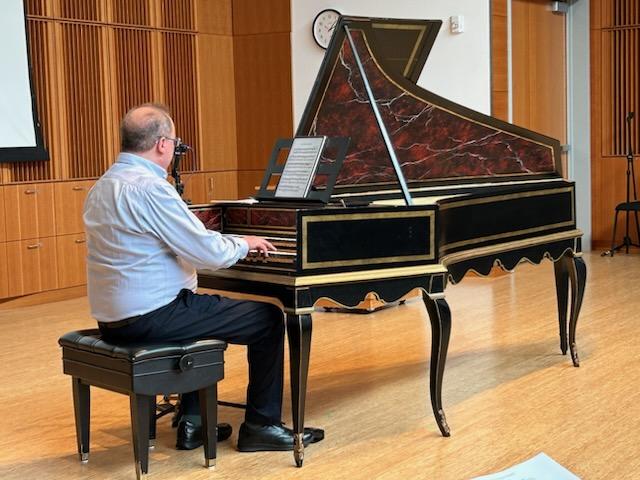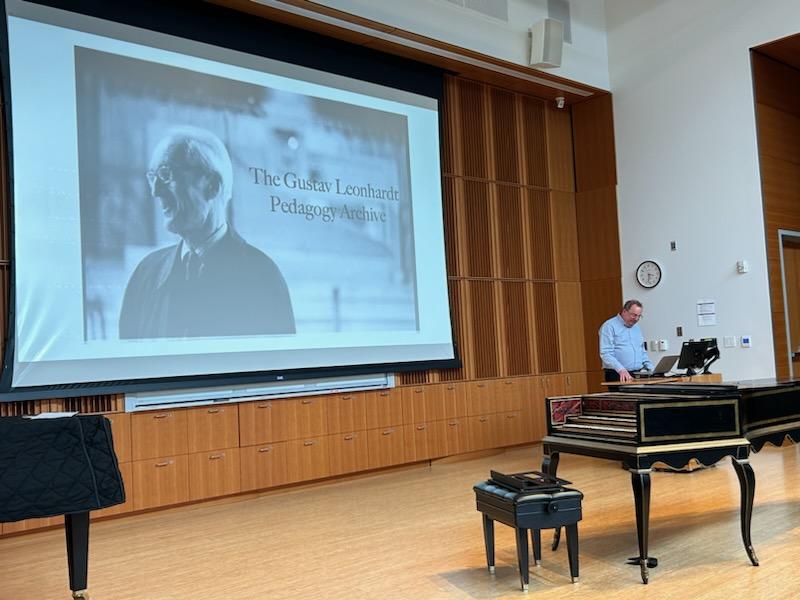Read More About the Event | Watch the Recital | Watch the Lecture | Printable Program
Douglas Amrine’s harpsichord recital and lecture on “The Leonhardt Legacy,” presented by WEKA on March 2, 2024, proved an inspiring event from several standpoints. All the repertoire came from the 17th century, which, as Amrine mentioned, is less commonly performed, and may be less readily accessible than 18th century music, as the emotions are less obvious and dramatic. However, he encouraged the audience to listen for moments of touching expression and the great panoply of effects mirroring the atmosphere of royal court entertainment. Especially admirable in Amrine’s performance were the steadiness of pulse throughout a piece, yet allowing for rhythmic flexibility and time for special moments, as well as a great variety of colors through register changes.

Varied Affekts were beautifully captured in Amrine’s masterful performance of several pieces by English virginalists (Martin Peerson, Robert Johnson, William Byrd, Orlando Gibbons, Thomas Tomkins, and Thomas Morley), including a wide variety of musical types – such as dance movements, fantasias, variations, and descriptive pieces (The Fall of the Leafe by Peerson and A Sad Pavan for These Distracted Times by Tomkins). According to the nature of the piece or phrase, Amrine created in turn touching simplicity and sweetness, or an incisive dancelike style. Especially beautiful was Tomkins’ A Sad Pavan, played on the front 8’ (upper manual), evoking a mournful quality; the relaxed tempo allowed one to savor its singing, sustained treble tones.
Interestingly, Amrine then played Purcell’s Suite in D Minor, in which the composer deliberately imitated French brisé (lute-like) style. As Amrine pointed out, since the English were not familiar with French style, Purcell precisely notated the staggered tones and notation. I’m sure it was a worthy endeavor, but to my ears, and probably inevitably, the result seemed a bit stilted and self-conscious. However, it was well and interestingly played. Amrine’s steady dance-like pulse for each movement, with flexibility as needed, provided the listener with a satisfying musical experience.
Before continuing, Amrine tuned the G-sharps to A-flats, since the harpsichord was in quarter-comma meantone, which brings out the pure 3rds that Renaissance composers prized. However, for instance, a pure E-G# produces a lower G# than the Ab of a pure Ab – C. Amrine then played music by Louis Couperin, beginning with his famous Tombeau de Mr Blancrocher, a lament for the great French lutenist after his death in 1652. The well-paced slow tempo allowed Couperin’s long-held harmonies to create a tragic effect.
The final work, Louis Couperin’s Suite in C Major, was a true highlight. Including two pièce croisée movements, in which the hands on two manuals cross each other within the same octave, they created — as Amrine described — an enchanting tonal effect of two different melodic instruments weaving around each other. The concluding Passacaille, with its hypnotic bass and powerfully ongoing pulse, bring us fully into the world of the French court.
The French style harpsichord used for this program, by Kenneth Bakeman, sounded absolutely superb. Paul Irvin, Reed College’s curator of the Early Keyboard Collection, has voiced the instrument to perfection; one can hardly even hear plucking, but rather, beautifully long-sustained singing tones that seem to emerge effortlessly, with a total clarity of pitch, and wonderful differentiation of registers. The treble tones’ sweetness took one’s breath away, and the bass was full yet clear, providing magisterial support. Douglas Amrine’s expressiveness, along with such beautiful harpsichord tone, made this a recital well worth hearing.

Following the recital, Douglas Amrine gave a highly interesting lecture about “The Leonhardt Legacy” and The Gustav Leonhardt Pedagogy Archive which he, Martha Cook, and Bruce Alan Brown founded in 2018. As Amrine stated, since Gustav Leonhardt (1928-2012) did not write down his thoughts, the archive is a key way to learn about his approach to harpsichord playing and teaching. Many key points were made, including these:
Leonhardt felt that live performance and a player’s connection to the audience were most important. He stated, “A recording represents music-making as poorly as a photograph represents an oil painting.” Rather, a performer should “captivate the audience with variety, imagination, fire and wit” and cause the audience to listen to each note. And, though he thoroughly studied historical treatises, and encouraged his students to do so, he stated: the performer must “bring to life the message of the composer” so “the score itself is our primary focus.”
His pedagogical approach was not dogmatic, but rather, he acknowledged that there is much the performer cannot know. Rather than insisting on his own interpretation, he encouraged students to discover their own artistic choices. Neither did he slavishly follow any particular rules, such as early fingerings.
Above all, Leonhardt emphasized the expression of a wide panoply of human emotions, conveying the composer’s “message,” and developing all the tools needed to convey them. Specific techniques he discussed were infinite gradations of articulation, and methods for creating nuanced dynamics, such as the effect of fading (the latter as through over-holding and staggered releases, etc.).
The Archive, which is an extremely interesting and valuable source of information that at present contains contributions from about 25 Leonhardt students, can be freely accessed online at: https://leonhardt-archive.com/